Intercapsomeric disulfide bonds in papillomavirus assembly and disassembly
- PMID: 9499072
- PMCID: PMC109511
- DOI: 10.1128/JVI.72.3.2160-2167.1998
Intercapsomeric disulfide bonds in papillomavirus assembly and disassembly
Abstract
In order to analyze bonding contacts that stabilize the virion or promote capsid assembly, bovine papillomavirus (BPV) virions were subjected to buffer conditions known to disrupt polyomavirus virions. At physiologic ionic strength, incubation with dithiothreitol (DTT), EGTA, or DTT plus EGTA did not disrupt BPV virions as determined by electron microscopy. However, incubation of virions with DTT rendered the BPV L1 protein susceptible to trypsin cleavage at its carboxy terminus and rendered the genome susceptible to digestion with DNase I. When DTT-treated BPV virions were analyzed by analytical ultracentrifugation, they sedimented at 230S compared with 273S for untreated virions, suggesting a capsid shell expansion. Incubation with EGTA had no effect on trypsin or DNase I sensitivity and only a small effect upon the virion S value. A single cysteine residue conserved among BPV and human papillomavirus (HPV) L1 proteins resides within the trypsin-sensitive carboxy terminus of L1, which is required for capsid assembly. A recombinant HPV type 11 L1 protein, which was purified after expression in Escherichia coli and which has a Cys-to-Gly change at this position (Cys424), formed pentamers; however, unlike the wild-type protein, these mutant pentamers could no longer assemble in vitro into capsid-like structures. These results indicate an important role for interpentamer disulfide bonds in papillomavirus capsid assembly and disassembly and suggest a mechanism of virus uncoating in the reducing environment of the cytoplasm.
Figures
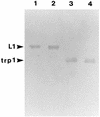
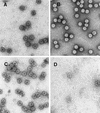
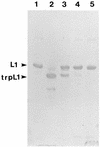
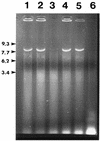
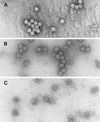
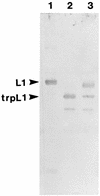

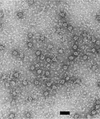

Similar articles
-
Expression of the human papillomavirus type 11 L1 capsid protein in Escherichia coli: characterization of protein domains involved in DNA binding and capsid assembly.J Virol. 1997 Apr;71(4):2988-95. doi: 10.1128/JVI.71.4.2988-2995.1997. J Virol. 1997. PMID: 9060658 Free PMC article.
-
Calcium is required in reassembly of bovine papillomavirus in vitro.J Gen Virol. 1998 May;79 ( Pt 5):1133-41. doi: 10.1099/0022-1317-79-5-1133. J Gen Virol. 1998. PMID: 9603328
-
Mutational analysis of human papillomavirus type 16 major capsid protein L1: the cysteines affecting the intermolecular bonding and structure of L1-capsids.Virology. 2003 Mar 30;308(1):128-36. doi: 10.1016/s0042-6822(02)00099-5. Virology. 2003. PMID: 12706096
-
Human papillomavirus 16 minor capsid protein L2 helps capsomeres assemble independently of intercapsomeric disulfide bonding.Virus Genes. 2005 Dec;31(3):321-8. doi: 10.1007/s11262-005-3250-3. Virus Genes. 2005. PMID: 16175337
-
Replication and assembly of human papillomaviruses.J Dent Res. 2009 Apr;88(4):307-17. doi: 10.1177/0022034509333446. J Dent Res. 2009. PMID: 19407149 Free PMC article. Review.
Cited by
-
Saccharomyces cerevisiae is permissive for replication of bovine papillomavirus type 1.J Virol. 2002 Dec;76(23):12265-73. doi: 10.1128/jvi.76.23.12265-12273.2002. J Virol. 2002. PMID: 12414966 Free PMC article.
-
The nuclear retention signal of HPV16 L2 protein is essential for incoming viral genome to transverse the trans-Golgi network.Virology. 2014 Jun;458-459:93-105. doi: 10.1016/j.virol.2014.04.024. Epub 2014 May 8. Virology. 2014. PMID: 24928042 Free PMC article.
-
The U4 Antibody Epitope on Human Papillomavirus 16 Identified by Cryo-electron Microscopy.J Virol. 2015 Dec;89(23):12108-17. doi: 10.1128/JVI.02020-15. Epub 2015 Sep 23. J Virol. 2015. PMID: 26401038 Free PMC article.
-
Human papilloma virus (HPV) profiles in breast cancer: future management.Ann Transl Med. 2020 May;8(10):650. doi: 10.21037/atm-19-2756. Ann Transl Med. 2020. PMID: 32566587 Free PMC article. Review.
-
Papillomavirus-like particles stimulate murine bone marrow-derived dendritic cells to produce alpha interferon and Th1 immune responses via MyD88.J Virol. 2004 Oct;78(20):11152-60. doi: 10.1128/JVI.78.20.11152-11160.2004. J Virol. 2004. PMID: 15452235 Free PMC article.
References
Publication types
MeSH terms
Substances
Grants and funding
LinkOut - more resources
Full Text Sources
Other Literature Sources

